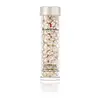What's inside
What's inside
 Key Ingredients
Key Ingredients

 Benefits
Benefits

 Concerns
Concerns

 Ingredients Side-by-side
Ingredients Side-by-side

Water
Skin ConditioningBifida Ferment Lysate
Skin ConditioningPEG-8
HumectantPropanediol
SolventBis-PEG-18 Methyl Ether Dimethyl Silane
EmollientMethyl Gluceth-20
HumectantGlycereth-26
HumectantPEG-75
HumectantButylene Glycol
HumectantAdansonia Digitata Seed Extract
Skin ConditioningTripeptide-32
Skin ConditioningSodium Hyaluronate
HumectantYeast Extract
Skin ConditioningLactobacillus Ferment
Skin ConditioningCola Acuminata Seed Extract
Skin ConditioningAnthemis Nobilis Flower Extract
MaskingHydrolyzed Algin
Pantethine
EmollientCaffeine
Skin ConditioningLecithin
EmollientSodium Rna
Skin ConditioningBisabolol
MaskingSqualane
EmollientGlycerin
HumectantOleth-3 Phosphate
Caprylyl Glycol
EmollientOleth-3
EmulsifyingOleth-5
EmulsifyingCholeth-24
EmulsifyingHydrogenated Lecithin
EmulsifyingJojoba Wax PEG-120 Esters
Ceteth-24
CleansingTocopheryl Acetate
AntioxidantCarbomer
Emulsion StabilisingTriethanolamine
BufferingTetrasodium EDTA
BHT
AntioxidantXanthan Gum
EmulsifyingPotassium Sorbate
PreservativeDisodium EDTA
Phenoxyethanol
PreservativeCI 14700
Cosmetic ColorantCI 19140
Cosmetic ColorantWater, Bifida Ferment Lysate, PEG-8, Propanediol, Bis-PEG-18 Methyl Ether Dimethyl Silane, Methyl Gluceth-20, Glycereth-26, PEG-75, Butylene Glycol, Adansonia Digitata Seed Extract, Tripeptide-32, Sodium Hyaluronate, Yeast Extract, Lactobacillus Ferment, Cola Acuminata Seed Extract, Anthemis Nobilis Flower Extract, Hydrolyzed Algin, Pantethine, Caffeine, Lecithin, Sodium Rna, Bisabolol, Squalane, Glycerin, Oleth-3 Phosphate, Caprylyl Glycol, Oleth-3, Oleth-5, Choleth-24, Hydrogenated Lecithin, Jojoba Wax PEG-120 Esters, Ceteth-24, Tocopheryl Acetate, Carbomer, Triethanolamine, Tetrasodium EDTA, BHT, Xanthan Gum, Potassium Sorbate, Disodium EDTA, Phenoxyethanol, CI 14700, CI 19140
Dimethicone
EmollientCaprylic/Capric Triglyceride
MaskingDimethicone/Vinyltrimethylsiloxysilicate Crosspolymer
Silica
AbrasiveEthylhexyl Palmitate
EmollientC12-15 Alkyl Benzoate
AntimicrobialDimethiconol
EmollientButylene Glycol
HumectantCeramide Ng
Skin ConditioningCeramide NP
Skin ConditioningCeramide Ns
Skin ConditioningCyclopentasiloxane
EmollientDiethylhexyl Syringylidenemalonate
Skin ProtectingEthylhexyl Cocoate
EmollientHelianthus Annuus Seed Oil
EmollientHydrogenated Castor Oil
EmollientHydrolyzed Sodium Hyaluronate
Skin ConditioningLactic Acid
BufferingLecithin
EmollientOlea Europaea Fruit Oil
MaskingPalmitoyl Hexapeptide-12
Skin ConditioningPEG-10 Phytosterol
EmulsifyingPentylene Glycol
Skin ConditioningPersea Gratissima Oil
Skin ConditioningPhytosphingosine
Skin ConditioningPhytosterols
Skin ConditioningPropylene Glycol Dicaprylate/Dicaprate
EmollientRicinus Communis Seed Oil
MaskingSilica Dimethyl Silylate
EmollientSodium Hyaluronate
HumectantTribehenin
EmollientZingiber Zerumbet Extract
Skin ConditioningPhenoxyethanol
PreservativeDimethicone, Caprylic/Capric Triglyceride, Dimethicone/Vinyltrimethylsiloxysilicate Crosspolymer, Silica, Ethylhexyl Palmitate, C12-15 Alkyl Benzoate, Dimethiconol, Butylene Glycol, Ceramide Ng, Ceramide NP, Ceramide Ns, Cyclopentasiloxane, Diethylhexyl Syringylidenemalonate, Ethylhexyl Cocoate, Helianthus Annuus Seed Oil, Hydrogenated Castor Oil, Hydrolyzed Sodium Hyaluronate, Lactic Acid, Lecithin, Olea Europaea Fruit Oil, Palmitoyl Hexapeptide-12, PEG-10 Phytosterol, Pentylene Glycol, Persea Gratissima Oil, Phytosphingosine, Phytosterols, Propylene Glycol Dicaprylate/Dicaprate, Ricinus Communis Seed Oil, Silica Dimethyl Silylate, Sodium Hyaluronate, Tribehenin, Zingiber Zerumbet Extract, Phenoxyethanol
 Reviews
Reviews

Ingredients Explained
These ingredients are found in both products.
Ingredients higher up in an ingredient list are typically present in a larger amount.
Butylene Glycol (or BG) is used within cosmetic products for a few different reasons:
Overall, Butylene Glycol is a safe and well-rounded ingredient that works well with other ingredients.
Though this ingredient works well with most skin types, some people with sensitive skin may experience a reaction such as allergic rashes, closed comedones, or itchiness.
Learn more about Butylene GlycolLecithin is a term for a group of substances found in the cell membranes of plants, animals, and humans. They are made up of mixture of phospholipids.
This ingredient has emollient and emulsifying properties.
As an emollient, lecithen helps soften the skin and creates a barrier to keep moisture in.
As an emulsifier, it also helps prevent water and oil ingredients from separating. Lecithin can also help ingredients be better absorbed by the skin.
This is because the phospholipids in lecithin produce liposomes. Liposomes help other ingredients get through the skin barrier.
Depending on the source of this ingredient, lecithin may not be fungal acne safe. This is because some sources of lecithin come from soybean oil, which may feed the malassezia yeast that feeds fungal acne.
We recommend reaching out to the brand you are purchasing from to inquire about the source of their lecithin.
Some other names for this ingredient include soy lecithin and deoiled soy lecithin.
Learn more about LecithinPhenoxyethanol is a preservative that has germicide, antimicrobial, and aromatic properties. Studies show that phenoxyethanol can prevent microbial growth. By itself, it has a scent that is similar to that of a rose.
It's often used in formulations along with Caprylyl Glycol to preserve the shelf life of products.
Sodium Hyaluronate is hyaluronic acid's salt form. It is commonly derived from the sodium salt of hyaluronic acid.
Like hyaluronic acid, it is great at holding water and acts as a humectant. This makes it a great skin hydrating ingredient.
Sodium Hyaluronate is naturally occurring in our bodies and is mostly found in eye fluid and joints.
These are some other common types of Hyaluronic Acid:
Learn more about Sodium Hyaluronate